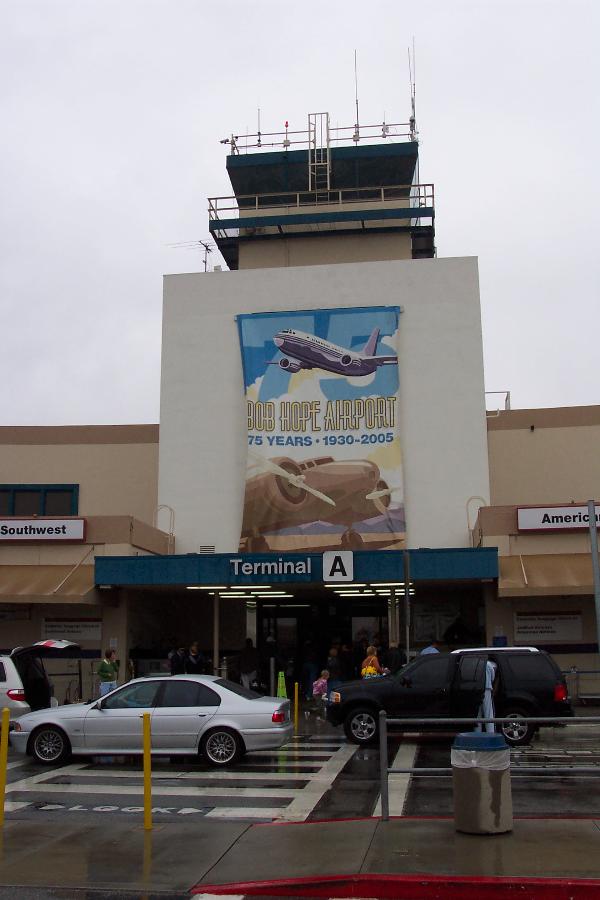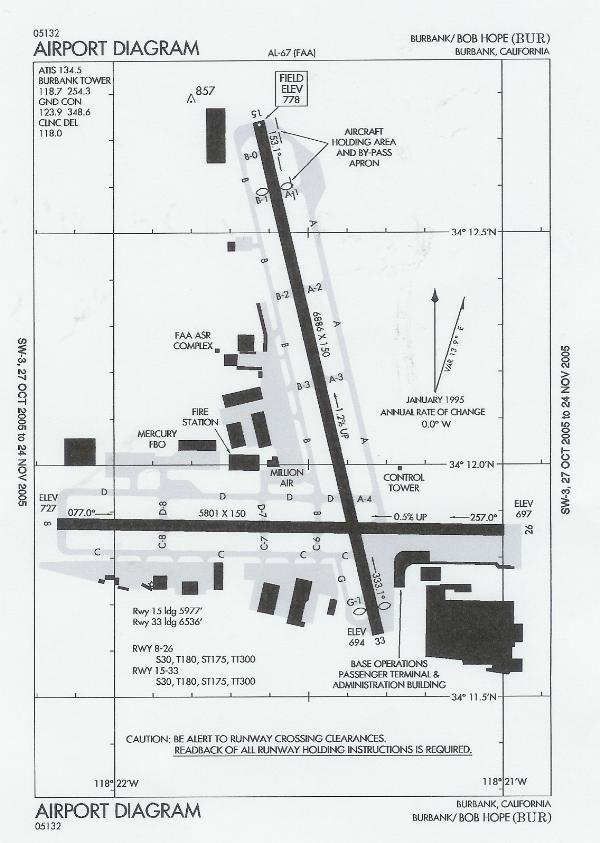
Bob Hope Airport - Burbank, CA
N 34° 11.782 W 118° 21.241
11S E 375243 N 3784757
Bob Hope Airport, located in Burbank, California, is the closest major airport to Downtown LA with easy access to and from Los Angeles and the San Fernando Valley.
Waymark Code: WM4F6
Location: California, United States
Date Posted: 12/03/2005
Views: 189


Bob Hope Airport is located in Burbank, California. The airport provides easy access to and from Burbank, Glendale, Pasadena and other nearby communities in the San Fernando Valley as well as being the closest airport to downtwon Los Angeles. It is one of five major airports serving the greater Los Angeles region. The other major airports are Los Angeles International Airport, Ontario International Airport, Long Beach Airport, and John Wayne Airport.
I really like this airport having flown in a number of times visiting friends and relatives in my native SoCal. The airport is a bit cramped and can be crowded, especially at baggage claim. There's not a lot of options for food and drink here. One thing I really like about this airport is that there are no jetways, you deplane down the air stairs like in the old days. In the terminal you can find a beautiful scale model of the P-38 Lightning, the famous twin-engined World War II fighter.
Bob Hope Airport is owned and operated by the Burbank-Glendale-Pasadena Airport Authority. The Burbank-Glendale-Pasadena Airport Authority is a separate government agency that was created under a joint powers agreement between the three cities of Burbank, Glendale, and Pasadena in 1977. The airport was renamed in honor of legendary entertainer Bob Hope in December, 2003.
The year 2005 marks Bob Hope Aiport's 75th Anniversary. Bob Hope Airport opened as United Airport in 1930 on Memorial Day weekend. It was said to be the first multimillion-dollar airport in the country, and it quickly became the primary airport for the greater Los Angeles region. In 1940, as World War II approached, Lockheed purchased the airport and began expanding its facilities in support of the war effort on land adjacent to the airport’s runways. Lockheed changed the airport’s name to Lockheed Air Terminal and continued to operate it as a commercial airport, even as thousands of B-17s, Hudson bombers, and P-38 fighters rolled off the assembly lines. After the war, all the major carriers moved to Los Angeles Municipal Airport, today’s LAX. But airline service returned to Burbank in a big way when jet airliners capable of using Burbank’s short runways came along in the late 1960s, and the airport caught on as the most convenient place for a quick flight to the Bay Area.
The "Skunk Works," the unofficial name for Lockheed Martin's Lockheed Advanced Development Projects Unit, were located near Bob Hope Airport. The Skunk Works were responsible for producing a number of famous aircraft, including the U-2, the SR-71 Blackbird, and the F-117. Recent projects include the F-35 JSF (Joint Strike Fighter). The Skunk Works originated with the World War II period, when the black projects of the Skunk Works were located near the Burbank Airport, now renamed Bob Hope Airport in Burbank, California. The legendary Kelly Johnson and team developed the P-80 Shooting Star in a circus tent set in the parking lot (as there was no existing secure area) in only 143 days. This aircraft was the U.S. Air Force's first operational jet fighter. Kelly Johnson headed the Skunk Works until 1975, when Ben Rich took over leadership. At the end of the Cold War in 1989, Lockheed reorganized its operations and relocated the Skunk Works to Site 10 at U. S. Air Force Plant 42 in Palmdale, California where it is still in operation today.
Some great historical information is available at Aviation History of the San Fernando Valley.


